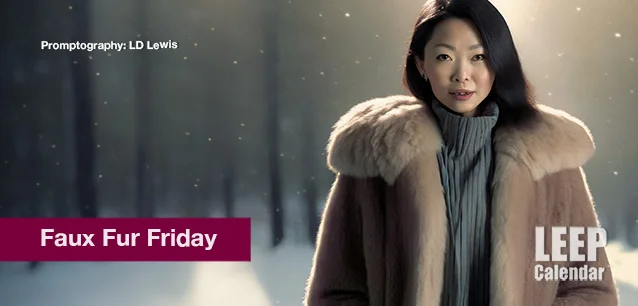 AD
AD
Today is: November 24
Scroll to explore events active on this date.
LEEP INK FEATURES

Nuanced November 2024
November is the start of the holiday season in many parts of the world. It is a time for family, football, food, shopping and decorating, particularly in the Christian and Jewish world, leading to Christmas and...

December's Gift
Events in December 2024. Well, we made it to December. December is the holiday season, particularly in Western nations, where Christianity and Judaism are the faiths most common in the nation's past. ...

August is Appropos
A toddler playing in the fountain at a park in Santa Fe, New Mexico—Photo LD Lewis. In August, we live through the Dog Days of Summer. It's hot and often humid, and those ...
About Faux Fur Friday
United States
Ends: Dec 05, 2025
DESCRIPTION:
Faux Fur Friday, on the first Friday of December, encourages using fake fur in fashion as an alternative to real animal fur. It is likely an add-on event created to augment the sponsored Fur Free Friday a week prior. Faux Fur Friday is an unofficial event with no sponsor.
The history of fur in human clothing dates back to ancient times, primarily driven by the need for warmth. In various cultures, real fur was a status and power symbol reserved for the elite, like ancient Egyptian royalty and European nobility. The use of fur as a luxury item continued for centuries.
Fake fur emerged in the 1800s, initially suggested for children's clothing. By the 1900s, fake fur, or imitation fur, began to gain popularity. Originally made from the wool of unborn or newborn lambs and later mixed with synthetic fibers, faux fur became increasingly affordable and popular by the 1950s, with companies vying to create luxurious synthetic versions.
The anti-fur movement, which gained momentum in the 1970s, further boosted the fake fur industry. Notable events in this movement include the Endangered Species Act of 1973, which aligned with anti-fur protests, and PETA's influential "Rather Go Naked Than Wear Fur" campaign in the 1990s, featuring supermodels like Naomi Campbell and Cindy Crawford. This period saw a significant shift in the fashion industry's attitude toward fur, with more brands and designers exploring cheaper faux fur options.
Today, faux fur is widely used in the garment and home fashion industry. It represents a fashion choice for some, affordability for others, and a stance on animal rights and veganism. However, due to its synthetic construction and disposable fast fashion inclusion, most faux fur is neither sustainable nor environmentally friendly.
VIDEOS
SUPPORTING DOCUMENTS
Currently, this event does not have supporting documents.
ADDITIONAL IMAGES
Currently, this event does not have supporting images.
Where would you like to go now?
 AD
AD


/footer-logo.svg)
